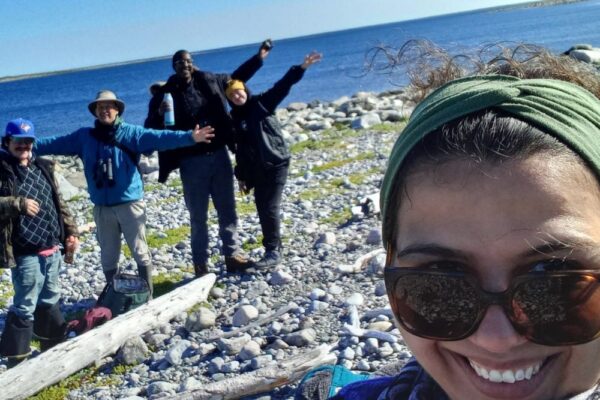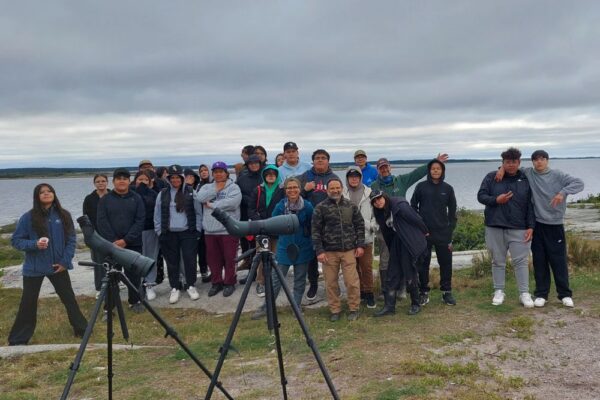Flying with Shorebirds
Field Notes from James Bay to Brasil
Nature Canada is working with partners across the western hemisphere to bring awareness and resources to communities who are in close proximity to important shorebird stopover sites. Our goal with this work is to support local stewardship of these threatened species and “Save Our Shorebirds“.
About the ‘Save Our Shorebirds’ program
In June of 2024, Nature Canada was approved for two years of funding from the Neotropical Migratory Bird Fund of the US Fish and Wildlife Service. We are thrilled to be awarded this grant which was matched by many other partners including the Canadian Wildlife Service, the Cree Nation Government, Moose Cree First Nation, Birds Canada, Manomet Conservation Sciences/Western Hemisphere Shorebird Reserve Network (WHSRN) and SAVE Brasil.
The essence of the work is to connect schools in Indigenous Cree communities in James Bay with schools in traditional communities in southern Brazil that share the very same birds: shorebirds.
This group of birds has been experiencing significant population declines, and one way of helping them recover is working with the communities they call home – sometimes briefly, other times for months in a row. Ensuring that their many ‘homes’ are in order for them to rest, refuel and raise their families is an important step in this direction.
Check out the field notes from Nature Canada’s Naturalist Team’s visits to these key sites. Get ready for an exciting update coming this November!
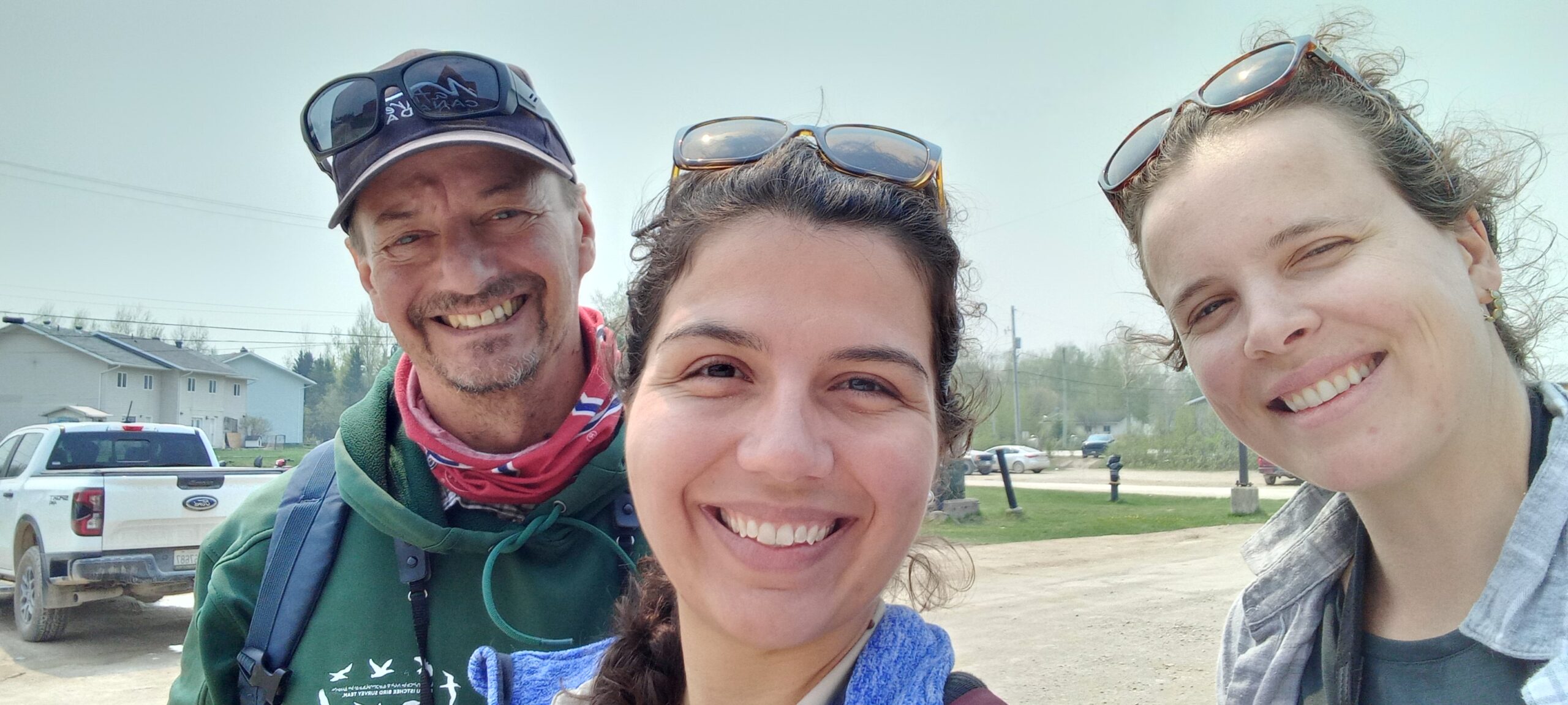
Why we’re doing this work
By engaging teachers and students through the Discover Shorebirds curriculum, we can reach the rest of the community. Our goal is to build local capacity for conservation through education, provision of resources and knowledge exchanges. Connecting knowledge holders with the classrooms grounds the learning in the local culture. Connecting students and teachers between Canada and Brazil who share the very same birds, broadens their perspectives and serves as an inspiration.
Connect with us
Become a Bird Defender
If you are interested in keeping up to date with the work Nature Canada is doing in James Bay to Brasil and beyond, please join our mailing list.
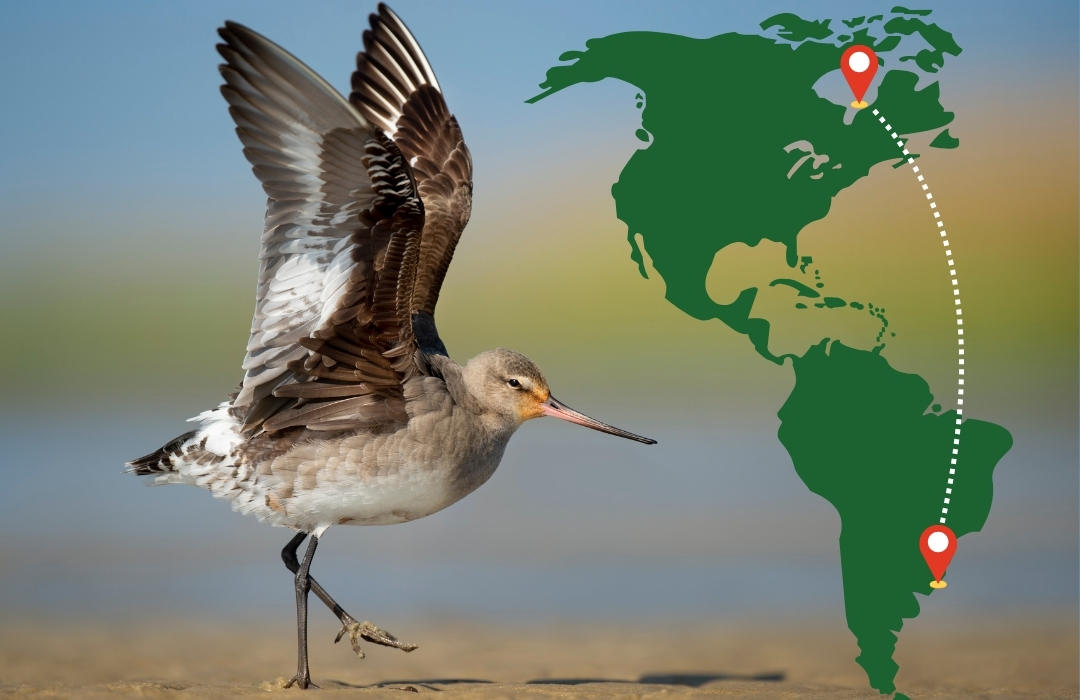
The Journey Thus Far
Students on the land learning from nature
By Ted Cheskey, Naturalist Director and Priscilla Santos, Policy and Conservation Senior Officer
April-May 2025
Lagoa do Peixe National Park, Rio Grande do Sul, Brasil
We milled about amongst students from the Izabel Cristina and Marcelo Gama schools, located by Lagoa do Peixe National Park in the Brazilian cities of Tavares and Mostardas, respectively. Ted shared his camera with them, teaching them quickly how to photograph the White-rumped Sandpipers, Black-bellied Plovers, Ruddy Turnstones and Lesser Yellowlegs, mingling amongst the massive Maguari Storks and the Roseate Spoonbills. We mused with students about how these birds would race us back to Canada. While many enjoyed the socializing, liberated by the absence of the four classroom walls, several of them marvelled at the stunning surroundings and wildlife.
We couldn’t pass up the opportunity for students of the 9th grade from Izabel Cristina School to connect virtually for the first time with students from the 7th-8th grade of the Delores D Echum Composite School (DDECS) from Moose Factory, Ontario.
Together with SAVE Brasil and Manomet partners, we met with several community members throughout the week, from teachers and local artists to Park management. We were also welcomed by traditional fishermen in one of their seasonal shrimp fishing camps. We talked about the challenges and achievements of the co-management approach currently in place for Lagoa do Peixe National Park, which is now an example of success inspiring management of other Brazilian National Parks!
Pictures:
1. Field trip with students from Izabel Cristina and Marcelo Gama schools
2. Birds at Lagoa do Peixe National Park
3. Priscilla facilitates first virtual live interaction between 9th grade students from Izabel Cristina school and 7th-8th grade students from DDECS
4. Leonice, from SAVE Brasil, talks about red knot weight variation throughout migration during visit to fishing camp
June 2025
Moosonee/Moose Factory, Ontario, Canada
After an almost 10h drive from Ottawa to Cochrane and a 5h Polar Bear Express train ride, Lara, Priscilla and Ted were ready for a week of field trips with students from DDECS and Moosonee Public School. We were joined by summer student Bella Cheecho, a recent DDECS graduate whose summer internship position with the Moose River Heritage and Hospitality Association was made possible thanks to this project, in partnership with Nature Canada’s Work to Grow youth employment program. Earlier in the year, we had met Batut at the annual Great Moon Gathering in Timmins, Ontario.
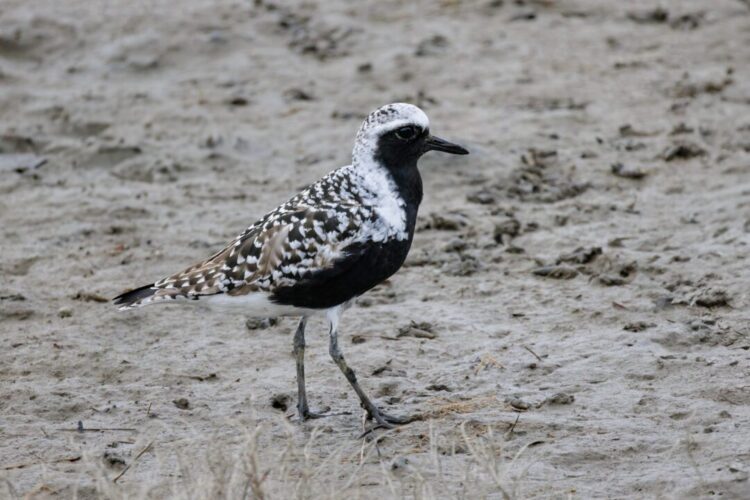
Throughout the week, groups of DDECS students clamoured off the boats onto the silty coastline of Shipsands Island. Most were hoping to see some of the shorebirds that their teachers had talked about – and geese, of course! Lara pointed at some birds, about 50 metres away. The sun reflected off the shimmering silvery backs of a small group of Black-bellied Plovers in stunning breeding plumages. We like to think that they accepted our meeting invitation made in Brazil just two months before – and changed clothes for the occasion. Priscilla told them how the Black-bellied Plover is not named after the colour of its belly but rather its wingpits (Batuiruçu-de-axila-preta = Black Wingpit Plover in Brazil, as the black belly does not molt in until the birds have departed towards their breeding territories in northern Canada but the wingpits stay black all year round. They certainly showed off their black bellies for us! They had likely just arrived and were nervously moving about on the low-cropped salt marsh vegetation (thanks to the geese). It’s too bad the smoky skies that week didn’t allow for great pictures.
Students took turns looking through telescopes and binoculars, many enthralled and fascinated by these long-winged visitors to their community. A few lucky students even held tiny songbirds in their hands to release into the wild, after an up-close bird banding activity led by us. Having full support from the school’s principal and teachers, group of elders, boat drivers, and so many other community members helping us make the most of these trips was undoubtedly a highlight.
We spent our last day in Moosonee with the 5th grade of the Moosonee Public School and their teacher, who is a birder and a great supporter of this work. We watched together a response video from Izabel Cristina school, sent to them with answers to the questions the group had asked Brazilian students, in a pre-recorded video, a few months before. We taught students how to use binoculars and spotting scopes, navigate bird ID books, and closed the day with how to be a good steward in mind and a clean-up walk around the school premises. The wildlife that calls the town home was appreciative, I’m sure – including shorebirds!
1 We are thankful to Vortex for their support to this project, allowing us to equip schools and key partners with high quality binoculars and scopes for their enjoyment and continued learning!
Pictures
1. Landing on Shipsands Island
2. Spotting birds with spotting scopes
3. Smoky picture of a Black Bellied Plover with Canada geese in the back
4. Last day of activities with the 5th grade from Moosonee Public School
August-September 2025
Chisasibi, Québec, Canada
Following a 17h+ drive from Ottawa – and weekend of adventure bird-watching on remote James Bay islands with a small group of Big River High teachers and boat captain Lawrence Napash – we guided groups of students from Big River High to Attawascotch, the terminus of the road and one of several boat launch locations. Teachers were excited to bring students to the field after having participated in a full day workshop about the project led by Lara and Priscilla last December. They had just started shorebird lessons in their classrooms!
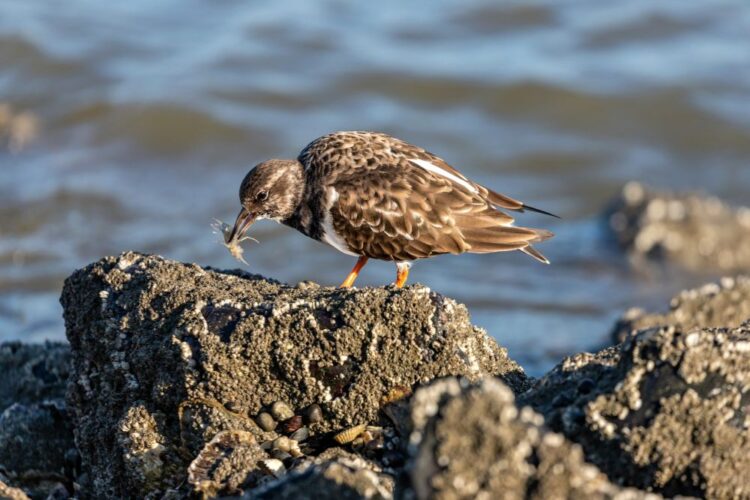
Our partners from the Chisasibi Environmental Research Institute (CERRI) joined too, helping with environmental measurements and sediment sampling. Thanks to CERRI, students learned about the numerous tiny shrimp-like amphipods that hid beneath the rocks. And with us, they learned about shorebirds who very much enjoy this delicacy – the Ruddy Turnstones (pictured above). Not only did they hear us talking about these birds, but they actually saw the Turnstones living up to their name and flipping small stones to access the hidden shrimps. It takes a shrimp feast to fatten up ahead of a long flight to the southernmost tip of South America. During free moments, socializing was important – but so was picking berries. The raspberries especially were abundant!
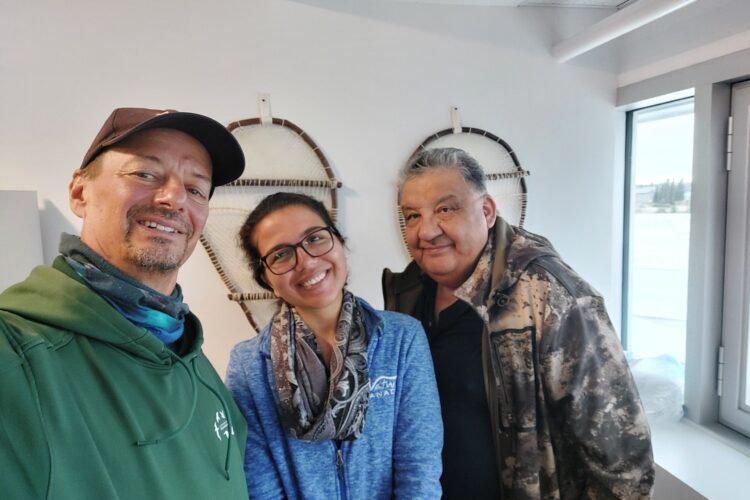
Once again, full support from the school’s principal and teachers – and so many other community members – was key in making the most of this visit. We took the opportunity to re-connect with some old friends, in particular elders Lucy Salt and Jimmy Fireman. Listening to their stories and sharing experiences from the field activities with students is always a pleasure – and learning opportunity. We are slowly but surely increasing our Cree shorebird vocabulary.
Pictures
1. James Bay birdwatching adventures with Big River High teachers and boat captain Lawrence Napash
2. Nature Canada, CERRI and Big River High teachers getting ready for field trips
3. Shrimp-like amphipods, an important food source for migratory shorebirds on the Chisasibi coastline
4. Ruddy Turnstones in flight, picture by Preston Sam
5. Big River High students, CERRI and Nature Canada on a shorebird field trip in Attawascotch
November 2025 – upcoming
Lagoa do Peixe National Park, Rio Grande do Sul, Brasil
We couldn’t miss the last leg of a full migration cycle of the summer chasing travellers of the Americas. We are therefore going back to Brazil to welcome shorebirds back to their favourite tropical summer grounds after sending them off from Chisasibi this past September. In fact, there is a whole festival dedicated to migratory birds happening, precisely to welcome them back. Schools, researchers, fishermen and so many other community members will all gather to celebrate these incredible migrants we’re lucky enough to share the world with. And even better, we will be able to bring James Bay along with us! Elders John and Linda Turner from Moose Factory, who are both bird lovers and active within the DDECS community, are joining us to experience community mobilization efforts around shorebirds on the other side of the continent. We are so looking forward to this trip.
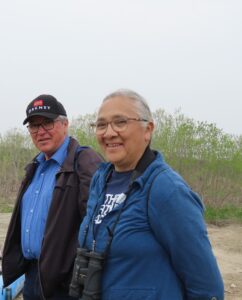
It’s a long way from James Bay to Lagoa do Peixe. We will cover 10 thousand kilometers travelling by boat, planes of all sizes, driving on remote roads and so forth. Lucky for us, our gas stations, restaurants and hotels are mapped or booked, and unlikely to disappear overnight.
The tiny shorebirds travelling on their own aren’t as lucky and, sometimes, arrive at their own versions of gas stations – stopover sites – just to find them gone.
This reminds us of the importance of this work. Being able to help connect the communities and schools, the people, the cultures, the stories, the traditions, and so much more that shorebirds carry with them has a role to play in protecting the places they call home. If these birds are gone, so are important pieces of our ecology, sure, but also of our identities. Working in true partnership is essential to make sure this does not happen!
Our Partners
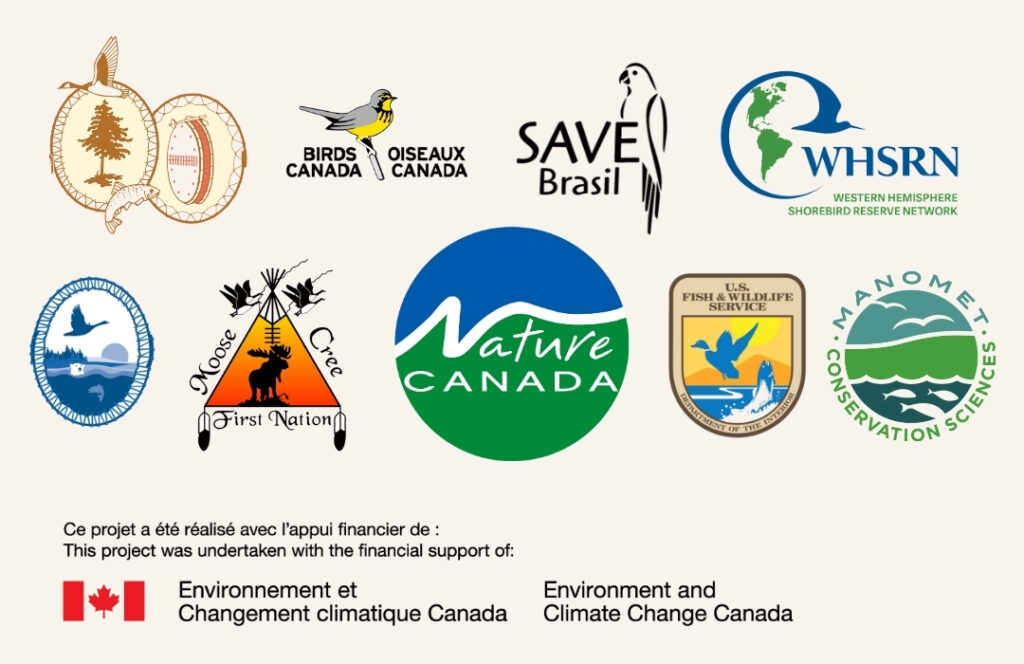
Resources
Resources used in the field and related educational materials produced through the work and collaboration this project inspired.
eBird
eBird is among the world’s largest biodiversity-related science projects, with more than 100 million bird sightings contributed annually by eBirders around the world and an average participation growth rate of approximately 20% year over year. A collaborative enterprise with hundreds of partner organizations, thousands of regional experts, and hundreds of thousands of users, eBird is managed by the Cornell Lab of Ornithology. eBird began with a simple idea—that every birdwatcher has unique knowledge and experience. Our goal is to gather this information in the form of checklists of birds, archive it, and freely share it to power new data-driven approaches to science, conservation and education. At the same time, we develop tools that make birding more rewarding. From being able to manage lists, photos and audio recordings, to seeing real-time maps of species distribution, to alerts that let you know when species have been seen, we strive to provide the most current and useful information to the birding community.
A Year in the Life of a Red Knot
Nature Canada and the CNG produced a comic book about the Red Knot, a species of shorebird that migrates through the coastal zone of James Bay in late spring and summer. The comic is about one particular Red Knot named RUFUS. It tells the remarkable story about the first year of Rufus’s life and his migration from its arctic breeding grounds on Southampton Island to the southern tip of South America and back – a 30,000 km round trip. Along the way, we learn about the threats to the species and the special areas where it likes to stop.
Great Travelers
Every year, great travelers pass through the homelands of the Cree along James Bay. These feathered superheroes are known as shorebirds. Learn about the shorebirds found in this region and how some of the Cree communities are doing things to help these birds with their partners.









